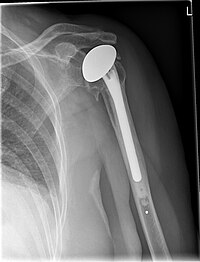
Photo from wikipedia
BACKGROUND Large glenoid defects present a challenge during primary and revision reverse total shoulder arthroplasty (RTSA) especially when humeral head autograft is not available as a bone graft source. The… Click to show full abstract
BACKGROUND Large glenoid defects present a challenge during primary and revision reverse total shoulder arthroplasty (RTSA) especially when humeral head autograft is not available as a bone graft source. The purpose of this study was to evaluate the clinical and radiographic outcomes of RTSA with concomitant structural allografting to reconstruct large glenoid defects. METHODS From May 2008 to July 2016, 22 patients underwent primary or revision RTSA with structural glenoid allografting. Of 22 patients, 19 (86%) were available for a minimum 2-year clinical follow-up (average, 2.8 ± 1.3 years), and 17 of 22 (77%) were available for a minimum 1-year radiographic follow-up. Functional outcomes, range of motion, radiographic deformity correction, allograft incorporation, and complication rates were determined. RESULTS From preoperatively to postoperatively, significant improvements in the average Simple Shoulder Test score (2 ± 2 preoperatively vs. 10 ± 8 postoperatively, P = .002), the average American Shoulder and Elbow Surgeons score (31 ± 19 preoperatively vs. 70 ± 25 postoperatively, P < .001), and average active forward elevation (71° ± 41° preoperatively vs. 128° ± 28° postoperatively, P < .001) were noted. Coronal-plane radiographic correction was 29° ± 12° as measured with the reverse shoulder arthroplasty angle (P < .001) and 14° ± 11° as measured with the β angle (P < .001). Postoperatively, of 17 patients with a minimum 1-year radiographic follow-up, 14 (82%) had complete radiographic incorporation of the graft. Acromial fracture nonunions developed in 2 patients and loosening and migration of the baseplate were found in 2 patients, although no patients elected to undergo further surgery. CONCLUSIONS RTSA with allograft reconstruction of severe glenoid defects allows restoration of glenoid anatomy and leads to high rates of bony incorporation with low rates of glenoid loosening or requirement for revision. Structural allograft is an excellent alternative to autograft in revision RTSA to avoid graft-site morbidity.
Journal Title: Journal of shoulder and elbow surgery
Year Published: 2019
Link to full text (if available)
Share on Social Media: Sign Up to like & get
recommendations!